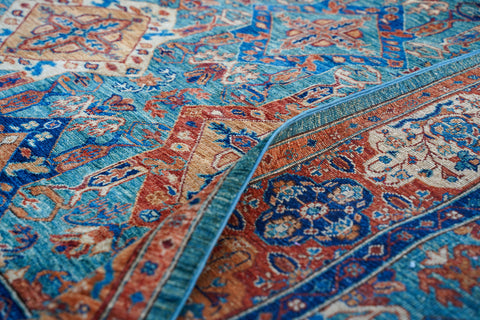
Afghan rugs are known for their quality, durability, and resilience. But often times my clients get confused about how to measure a rug's quality.
There's a lot that goes into measuring a rug's quality, such the type of wool used to weave the rug, the country of origin, whether the dyes are natural or synthetic, the experience of the artisans, the process used to wash and finish the rug, and the knots per square inch (KPSI) (among other things).

So what is KPSI? KPSI is exactly what it sounds like -- the number of knots vertically multiplied by the number of knots horizontally across a one square inch area of the rug.
To calculate KPSI, all you have to do is the following:
- Grab a ruler or measuring tape;
- Flip the rug over so you're looking at the backside of the rug (opposite the pile) — this is where you can see all the tiny knots;
- Place your ruler underneath the knots horizontally, and count how many knots you see across one inch;
- Then place your ruler vertically, and count how many knots you see across on inch vertically;
- Multiple the number of horizontal and vertical knots (the area), and voila! The product is the number is the approximate KPSI.
The lower the KPSI, the bigger the knots on the backside of the rug; the higher the KPSI, the smaller the knots. Rugs with higher KPSI tend to have more details in their design.
Afghan rugs typically have anywhere from 30 to 150 KPSI, but they can be as high as 500 KPSI. The Mamluk-designed rugs in my collection typically have the highest, averaging 144 KPSI, which is why they are typically more expensive than other rugs in my collection (because they require more raw materials and take the artisans much longer to make).
Some of my clients custom-order rugs with much higher KPSI, which is an option if you are customizing a rug with me.
Think of the pixels in an image. The higher the resolution (the more pixels), the clearer the image will be; the lower the resolution (the less pixels), the blurrier it will be.

The same is true with rugs. Artisans are able to create "finer" and more detailed rugs the more KPSI they weave into the rug. Rugs with intricate designs (vs. simple geometric designs) or rugs with imagery typically require crisper and clearer images, so they require higher KPSI.
A Word of Caution
When you're shopping for a rug, be extremely cautious about the representations made by some folks about the KPSI.
Unfortunately, my clients have reported that some shops inflate the KPSI by using a complicated equation other than the one I have described.
Others claim that there is such thing as a double-knotted "Afghan knot," so they say that each knot counts as two knots when you calculate the KPSI. This is inaccurate. I learned that the shop making this representation was referring to the Turkish knot, which is simply one knot that is tied around two adjoining warp strands (the warp is the rug's foundation — see picture below).

Historically, Afghan artisans have used either the Turkish or Persian knots to weave their rugs (more on these knots in a forthcoming article), but there is no such thing as an "Afghan knot" that counts as two knots when calculating the KPSI.
Summary
- KPSI is simply the number of knots woven vertically x the number of knots woven horizontally, which you can calculate by looking at the backside of a rug.
- KPSI is not the only measure of a rug's quality. There are many other factors that go into making a quality rug.
- Don't take representations of the KPSI at face value. Ask the rug shop for pictures of the rug's backside so you can count the number of horizontal and vertical knots.
- If a rug shop uses an equation other than the one I described, or if they are claiming one knot counts as two knots, think twice. They might be misinformed, or they could be inflating the KPSI.
If you ever have any questions about the rug's KPSI, or if you would like to know the KPSI of a rug from my shop, please contact me. I would be happy to help!
